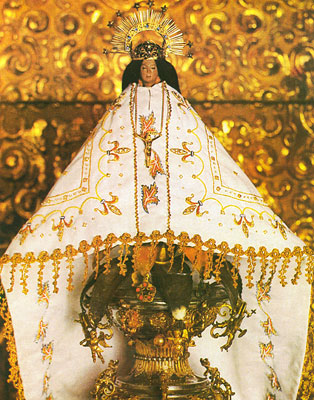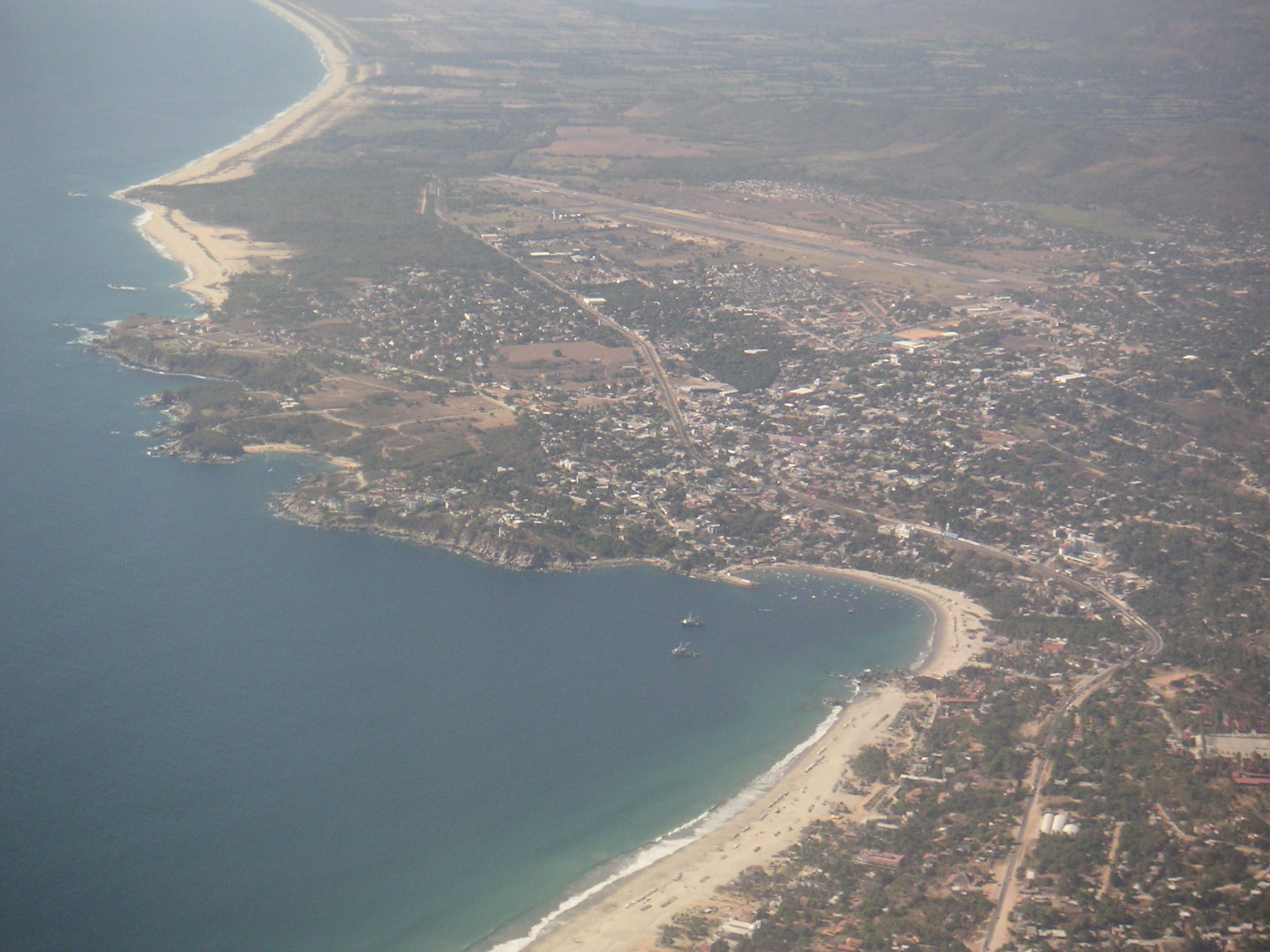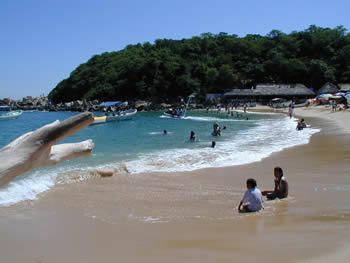|
Juquila
Santa Catarina Juquila is a town in the State of Oaxaca, Mexico, and is the seat of the municipality also called Santa Catarina Juquila. It is part of the Juquila District in the center of the Costa Region. The name "Juquila" comes from "Xuhquililla", which means "Place of blue milkweed". Environment The total area of the municipality is 811.42 km2 in rugged terrain in the foothills of the Sierra Madre del Sur. The climate is temperate humid, with maximum temperatures of 20 °C, minimum 12 °C and average 16 °C.. Annual rainfall is 854 mm, higher from May to September and lower from October to April. Trees include pine, oak, mahogany, cedar, oak, coral, topehuaje, blackwood, ebony, jacaranda and ash. Fruit trees include orange, lemon, mamey, banana, pomegranate and guava. Wild fauna are deer, badgers, iguana and armadillo. Town The town has a population of 5,579 inhabitants and is at an altitude of 1,462 meters above sea level. It is located north of P ... [...More Info...] [...Related Items...] OR: [Wikipedia] [Google] [Baidu] |
Juquila District
Juquila District is located in the center of the Costa Region of the State of Oaxaca, Mexico, on the Pacific coast. It has an area of 5,055 km2. As of 2005 it had a total population of 134,365 of whom 33,106 spoke an indigenous language. Economic activities include agriculture and tourism. The Santuario (Sanctuary) de Juquila is a major attraction. Environment The district lies on the Pacific coast of southwestern Oaxaca, with generally hilly land rising to the southern edge of the Sierra Madre del Sur. The coastal climate is hot and humid, while inland the climate is warm and humid. The western part of the district includes the Lagunas de Chacahua National Park, which includes the lagoons of Chacahua, La Pastoria, Las Salinas. Economy The most important economic activity is agriculture, including cultivation of maize, beans and vegetables for personal consumption. The people practice animal husbandry on a small scale, and some also hunt and fish. Coffee is grown inland, ... [...More Info...] [...Related Items...] OR: [Wikipedia] [Google] [Baidu] |
Costa Region
The Costa Region or Costa Chica lies on the Pacific coast of the state of Oaxaca, Mexico, south of the more mountainous Sierra Sur inland from the coast. It includes the districts of Jamiltepec, Juquila and Pochutla. Climate The region has a tropical climate in the coastal plain, with a more temperate climate higher up. Average temperatures range between , and maximum annual rainfall is between - Economy The population is mainly engaged in agriculture and waterfront fisheries. One of the best coffees in the world, the Pluma Hidalgo, is cultivated in the Pochutla district. In other parts of the region lemons are grown to make lemon oil, a raw material for perfumes and medicines. Pine and oak wood is harvested for plywood. Ranching is a major source of revenue. There is also small-scale exploitation of iron, copper and magnesium, and the region has titanium deposits. It is a tourist region, based on the beaches of Huatulco and Puerto Escondido. To develop this industry ... [...More Info...] [...Related Items...] OR: [Wikipedia] [Google] [Baidu] |
Oaxaca
) , population_note = , population_rank = 10th , timezone1 = CST , utc_offset1 = −6 , timezone1_DST = CDT , utc_offset1_DST = −5 , postal_code_type = Postal code , postal_code = 68–71 , area_code_type = Area code , area_code = , iso_code = MX-OAX , blank_name_sec1 = HDI , blank_info_sec1 = 0.710 Ranked 31st of 32 , blank_name_sec2 = GDP , blank_info_sec2 = US$ 18.18 billion (2020) Ranked 20th of 32 , website = Oaxaca ( , also , , from nci, Huāxyacac ), officially the Free and Sovereign State of Oaxaca ( es, Estado Libre y Soberano de Oaxaca), is one of the 32 states that compose the Federative Entities of Mexico. It is divided into 570 municipalities, of which 418 (almost three quarters) are governed by the system of (customs and traditions) with recognized local ... [...More Info...] [...Related Items...] OR: [Wikipedia] [Google] [Baidu] |
Chatinos
The Chatinos are an indigenous people of Mexico. Chatino communities are located in the southeastern region of the state of Oaxaca in southern central Mexico. Their native Chatino language are spoken by about 23,000 people (Ethnologue surveys), but ethnic Chatinos may number many more. The Chatinos of San Juan Quiahije call themselves ''neq-a tnya-j'' and their language ''Chaq-f tnya-b''. Chatino populations are found in the following Oaxacan municipalities, mostly in the area around Juquila: Santos Reyes Nopala, San Juan Quiahije or KichinA kiqyaC, San Miguel Panixtlahuaca or KchinA SkwiE, Santiago Yaitepec or KeG XinE, Santa Cruz Zenzontepec or QyaC ytiB, San Juan Lachao or TsoH, Santa María Temaxcaltepec or XyanA, Santa Catarina Juquila or SqweF and Tataltepec de Valdés or LoA qoJ. The region that the Chatinos inhabit is rich in natural resources. Traditionally many Chatino people have been involved in agriculture, which depends very much on the climate, so some Chatino ... [...More Info...] [...Related Items...] OR: [Wikipedia] [Google] [Baidu] |
Zapotec Peoples
The Zapotecs ( Valley Zapotec: ''Bën za'') are an indigenous people of Mexico. The population is concentrated in the southern state of Oaxaca, but Zapotec communities also exist in neighboring states. The present-day population is estimated at approximately 400,000 to 650,000 persons, many of whom are monolingual in one of the native Zapotec languages and dialects. In pre-Columbian times, the Zapotec civilization was one of the highly developed cultures of Mesoamerica, which, among other things, included a system of writing. Many people of Zapotec ancestry have emigrated to the United States over several decades, and they maintain their own social organizations in the Los Angeles and Central Valley areas of California. There are four basic groups of Zapotecs: the ', who live in the southern Isthmus of Tehuantepec, the ', who live in the northern mountains of the Sierra Madre de Oaxaca, the southern Zapotecs, who live in the southern mountains of the Sierra Sur, and the Centr ... [...More Info...] [...Related Items...] OR: [Wikipedia] [Google] [Baidu] |
Union Of Indigenous Communities Of The Isthmus Region
The Union of Indigenous Communities of the Isthmus Region ( es, Unión de Comunidades Indígenas de la Región del Istmo, or UCIRI), is a farmer's cooperative in the state of Oaxaca, Mexico. It was established in 1982 to assist in production, marketing and distribution of locally produced coffee and other products. UCIRI was a pioneer of organic coffee production and one of the first fair trade suppliers. Early days Until the late 1970s the small coffee farmers of the Santa Maria Guienagati and Guevea de Humboldt municipalities in the Tehuantepec District of the Istmo Region of Oaxaca did not have roads and transport to get their product to market, and lacked bargaining power with the freelance coffee buyers. However, loggers built rough roads in the 1970s, and the roads were maintained after the loggers left or were driven out. The producers began selling direct to Inmecafe, the Mexican Institute of Coffee, which paid more than the middlemen. In 1982 the farmers of the two mu ... [...More Info...] [...Related Items...] OR: [Wikipedia] [Google] [Baidu] |
Puerto Escondido, Oaxaca
Puerto Escondido ( English: "Hidden Port") is a small port and tourist center in the municipality of San Pedro Mixtepec Distrito 22 in the Mexican state of Oaxaca. Prior to the 1930s, there was no town. The bay had been used as a port intermittently to ship coffee, but there was no permanent settlement due to the lack of potable water. The name "Puerto Escondido" had roots in the legend of a woman who escaped her captors and hid here. The Nahuatl word for this area was Zicatela, meaning “place of large thorns". Today, it refers to the area's most famous beach. Puerto Escondido is one of the most important tourist attractions on the Oaxacan coast. It caters to a more downscale and eclectic clientele than neighboring Huatulco, mostly surfers, backpackers and Mexican families. The main attractions are the beaches: Zicatela Beach hosts major surfing competitions, while other beaches have gentle waves. A large lagoon area to the west of the town is popular for fishing and birdwat ... [...More Info...] [...Related Items...] OR: [Wikipedia] [Google] [Baidu] |
Municipalities Of Mexico
Municipalities ('' municipios'' in Spanish) are the second-level administrative divisions of Mexico, where the first-level administrative division is the ''state'' (Spanish: estado). They should not be confused with cities or towns that may share the same name as they are distinct entities and do not share geographical boundaries. As of January 2021, there are 2,454 municipalities in Mexico, excluding the 16 boroughs of Mexico City. Since the 2015 Intercensal Survey, two municipalities have been created in Campeche, three in Chiapas, three in Morelos, one in Quintana Roo and one in Baja California. The internal political organization and their responsibilities are outlined in the 115th article of the 1917 Constitution and detailed in the constitutions of the states to which they belong. are distinct from , a form of Mexican locality, and are divided into '' colonias'' (neighborhoods); some municipalities can be as large as full states, while cities can be measured in b ... [...More Info...] [...Related Items...] OR: [Wikipedia] [Google] [Baidu] |
Administrative Divisions Of Mexico
The United Mexican States ( es, Estados Unidos Mexicanos) is a federal republic composed of 32 federal entities: 31 states and Mexico City, an autonomous entity. According to the Constitution of 1917, the states of the federation are free and sovereign in all matters concerning their internal affairs. Each state has its own congress and constitution. Federal entities of Mexico States Roles and powers of the states The states of the Mexican Federation are free, sovereign, autonomous and independent of each other. They are free to govern themselves according to their own laws; each state has a constitution that cannot contradict the federal constitution, which covers issues of national competence. The states cannot make alliances with other states or any independent nation without the consent of the whole federation, except those related to defense and security arrangements necessary to keep the border states secure in the event of an invasion. The political organiza ... [...More Info...] [...Related Items...] OR: [Wikipedia] [Google] [Baidu] |
North American Central Time Zone
The North American Central Time Zone (CT) is a time zone in parts of Canada, the United States, Mexico, Central America, some Caribbean Islands, and part of the Eastern Pacific Ocean. Central Standard Time (CST) is six hours behind Coordinated Universal Time (UTC). During summer, most of the zone uses daylight saving time (DST), and changes to Central Daylight Time (CDT) which is five hours behind UTC. The largest city in the Central Time Zone is Mexico City; the Mexico City metropolitan area is the largest metropolitan area in the zone and in North America. Regions using (North American) Central Time Canada The province of Manitoba is the only province or territory in Canada that observes Central Time in all areas. The following Canadian provinces and territories observe Central Time in the areas noted, while their other areas observe Eastern Time: * Nunavut (territory): western areas (most of Kivalliq Region and part of Qikiqtaaluk Region) * Ontario (province): a ... [...More Info...] [...Related Items...] OR: [Wikipedia] [Google] [Baidu] |
Mexico
Mexico ( Spanish: México), officially the United Mexican States, is a country in the southern portion of North America. It is bordered to the north by the United States; to the south and west by the Pacific Ocean; to the southeast by Guatemala, Belize, and the Caribbean Sea; and to the east by the Gulf of Mexico. Mexico covers ,Mexico '' The World Factbook''. . making it the world's 13th-largest country by area; with approximately 12 ... [...More Info...] [...Related Items...] OR: [Wikipedia] [Google] [Baidu] |





